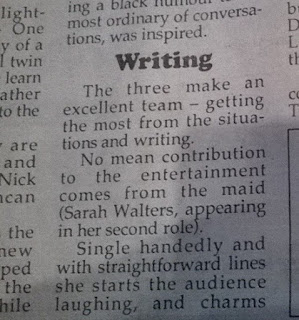‘Curtain Up’
(1952) showcases Margaret Rutherford at her eccentric best; while sparring with
Robert Morley, who is more than up to the task.
The setting for the film is a dreary provincial theatre, where a third
rate repertory company are meant to be rehearsing a new play. They are less than enthusiastic. The play has
been foisted on them by a member of theatre management, having been written by
an amateur relative of his. The task of
putting the play together is then made even more difficult by the arrival of
said author (Rutherford) who insists on interfering. With Morley as producer –
well, anyone familiar with 1950s British films doesn’t need a description of
the ensuing comedic situations.
 |
| Margaret Rutherford by @aitchteee |
Although not a
great deal happens – all of the film stays within the theatre confines – it is
good fun. There are some very funny
exchanges and a wonderful cameo from Joan Hickson as Morley’s affronted
landlady. The cast also features Kay Kendall – as beautiful and capable as
ever. Having dabbled in amateur
dramatics myself many years ago (my Mabel Middy in ‘Wanted, One Body’ was a
triumph - see my review below!) I can also see how there may be a lot of truth in this portrayal of
life in rep theatre. It was based on a play written by an actor, Philip King,
who must surely have known first hand what life was like there.
 |
| One of my clippings from the Derbyshire Times circa 1997, darlings |
This was an
interesting viewpoint. Those of us who
enjoy a good biography of our favourite 20th century actor cannot
fail to have read a lot about rep theatre. I’ve been doing a bit of that myself
lately, while trying to trace the life of Thorley Walters (see my Facebook
group page https://www.facebook.com/groups/669410206497159/) who followed up his Old Vic debut with a stint at Manchester Rep. Anyone worth their salt on screen in the 40s or 50s had cut their teeth in provincial rep. It was the acknowledged training ground after
theatre school. Many actors loved and
hated it. It was hard work – they had to
learn a new play every week, rehearsing one then performing another in quick
succession. They often had to live in
rotten digs and put up with bitching and big headed colleagues. But it taught them their trade and they
learned a great deal from it. They were
days of promise – who knew when they might be spotted by an agent?
So to see a
portrayal on screen brought a new dimension to that picture portrayed in so
many diaries and autobiographies. We see
the petty jealousies, the little Hitlers and the over-inflated egos. We also see talent going to waste and lack of
talent triumphing due to an absence of self-knowledge coupled with a big mouth.
Fascinating and fun!

